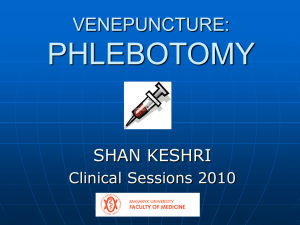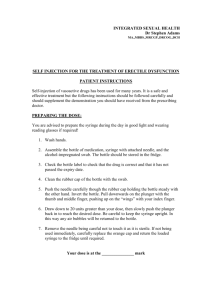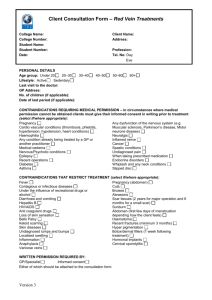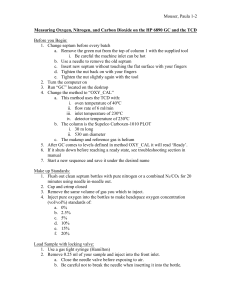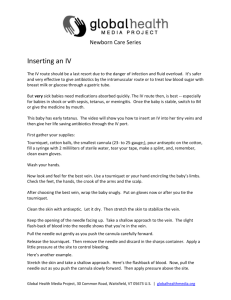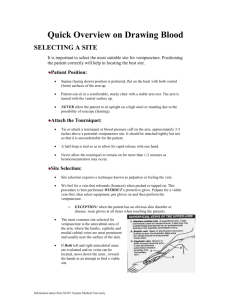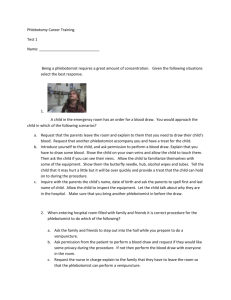Phlebotomy - Jenny Blair
advertisement
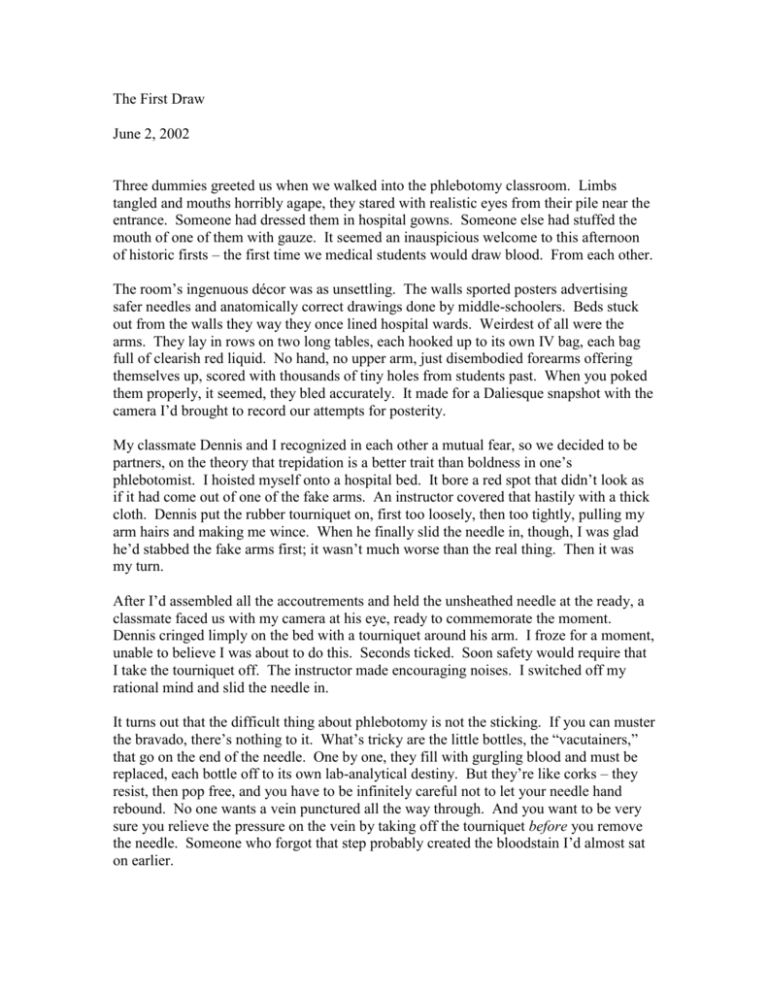
The First Draw June 2, 2002 Three dummies greeted us when we walked into the phlebotomy classroom. Limbs tangled and mouths horribly agape, they stared with realistic eyes from their pile near the entrance. Someone had dressed them in hospital gowns. Someone else had stuffed the mouth of one of them with gauze. It seemed an inauspicious welcome to this afternoon of historic firsts – the first time we medical students would draw blood. From each other. The room’s ingenuous décor was as unsettling. The walls sported posters advertising safer needles and anatomically correct drawings done by middle-schoolers. Beds stuck out from the walls they way they once lined hospital wards. Weirdest of all were the arms. They lay in rows on two long tables, each hooked up to its own IV bag, each bag full of clearish red liquid. No hand, no upper arm, just disembodied forearms offering themselves up, scored with thousands of tiny holes from students past. When you poked them properly, it seemed, they bled accurately. It made for a Daliesque snapshot with the camera I’d brought to record our attempts for posterity. My classmate Dennis and I recognized in each other a mutual fear, so we decided to be partners, on the theory that trepidation is a better trait than boldness in one’s phlebotomist. I hoisted myself onto a hospital bed. It bore a red spot that didn’t look as if it had come out of one of the fake arms. An instructor covered that hastily with a thick cloth. Dennis put the rubber tourniquet on, first too loosely, then too tightly, pulling my arm hairs and making me wince. When he finally slid the needle in, though, I was glad he’d stabbed the fake arms first; it wasn’t much worse than the real thing. Then it was my turn. After I’d assembled all the accoutrements and held the unsheathed needle at the ready, a classmate faced us with my camera at his eye, ready to commemorate the moment. Dennis cringed limply on the bed with a tourniquet around his arm. I froze for a moment, unable to believe I was about to do this. Seconds ticked. Soon safety would require that I take the tourniquet off. The instructor made encouraging noises. I switched off my rational mind and slid the needle in. It turns out that the difficult thing about phlebotomy is not the sticking. If you can muster the bravado, there’s nothing to it. What’s tricky are the little bottles, the “vacutainers,” that go on the end of the needle. One by one, they fill with gurgling blood and must be replaced, each bottle off to its own lab-analytical destiny. But they’re like corks – they resist, then pop free, and you have to be infinitely careful not to let your needle hand rebound. No one wants a vein punctured all the way through. And you want to be very sure you relieve the pressure on the vein by taking off the tourniquet before you remove the needle. Someone who forgot that step probably created the bloodstain I’d almost sat on earlier. When I finished my painstaking bottle transfers and pulled the needle out at last, Dennis leaned back and breathed loudly. His only criticism, he informed me evenly, was that he could feel me counterpushing the needle in as I was easing off the first bottle. Oops. So that was why he’d moaned. Still, I’d done it. I’d drawn blood. Light with success, I wandered over to Tara, who’d been having bad luck; she’d tried several times to stick her partner, but hadn’t been able to get the blood flowing. Now that the worst was over, I felt expansive, and grandly offered her an arm. Under the instructor’s watchful eye – and mine – she pushed the needle in. So far, so good. Unfortunately, as I watched, it kept on going. Less and less of the glint of its barrel showed, until I felt it necessary to shout. Then she tried to push the bottle on, and the needle wagged dangerously. I envisioned the little bevel waving around in my bloodstream, shaving off bits of inner-vein, and, wanting none of that, I continued to yelp strategically as I eyed the changing angle. Tara’s hand shook. Finally she got the bottle on, without, as far as I could judge, jabbing any deeper, (though I did wonder how wide my vein was compared with the amount of needle that had sunk out of sight). My blood flowed in, or “flashed,” as they say. One down. Now she had to replace it with another. I sweated. She accomplished the removal steadily enough, but as she reached for the other bottle, the first began to roll off the table. Tara caught it deftly, reaching one hand over another. The needle swung a compass point or two. I prayed. Finally she got the last bottle on and off. Helpfully, I took the tourniquet off myself, and Tara put gauze over the needle and slid it out. We praised her, and I made a mental note not to wear short sleeves that evening. Then she offered me her own arm, but I felt I’d better quit while I was ahead, so I put on a Band-Aid instead and told her she’d always remember me now. The thought made me happy. We eased our shoulders into backpacks gingerly, not wanting to tax our perforated veins, and left the row of beds, bags, and Arms behind. The dummies at the door gaped a mute farewell, and I snapped a picture. Copyright 2002, Hartford Courant
